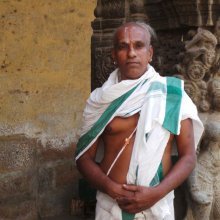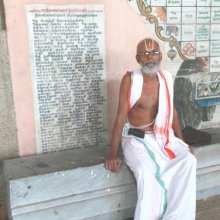Sthalapurana, Sthalapurāṇa, Sthala-purana: 6 definitions
Introduction:
Sthalapurana means something in Hinduism, Sanskrit, the history of ancient India. If you want to know the exact meaning, history, etymology or English translation of this term then check out the descriptions on this page. Add your comment or reference to a book if you want to contribute to this summary article.
Images (photo gallery)
In Hinduism
Shaivism (Shaiva philosophy)
Source: Wikipedia: ShaivismSthala Puranas.—This corpus of texts tells of the origins and traditions of particular Tamil Shiva temples or shrines. There are numerous Sthala Puranas, most written in vernaculars, some with Sanskrit versions as well. The 275 Shiva Sthalams of the continent have puranas for each, famously glorified in the Tamil literature Tevaram.
Source: DSpace at Pondicherry: Siddha Cult in Tamilnadu (shaivism)Sthalapurāṇa (स्थलपुराण).—There exists several Sthalapurāṇa which carries information about the Siddhas of Tamiḻnādu, where they lived or connected with the local temples. One among them is the Paḻaṉittalapurāṇam of Bālasubramania Kavirāyar (17th century), which gives us stray references to Gōrakkar’s visit to Paḻaṉi and his miracles.

Shaiva (शैव, śaiva) or Shaivism (śaivism) represents a tradition of Hinduism worshiping Shiva as the supreme being. Closely related to Shaktism, Shaiva literature includes a range of scriptures, including Tantras, while the root of this tradition may be traced back to the ancient Vedas.
India history and geography
Source: DSpace at Pondicherry: Siddha Cult in Tamilnadu (historical)Sthalapurāṇas are innumerable. There is a purāṇa for every little shrine in the Tamiḻnādu. It glorifies the shrine; the deity installed there, the temple tank and the temple tree. In fact, it is glorified with local legend and written with a religious bias. It may also be considered as a collection of local folk tales. Such books were first written in the 16th century and they continue to be written to the present day.
Source: Cologne Digital Sanskrit Dictionaries: Indian Epigraphical GlossarySthala-purāṇa.—(IA 30), a eulogistic work on a holy place, river, etc. Cf. māhātmya. Note: sthala-purāṇa is defined in the “Indian epigraphical glossary” as it can be found on ancient inscriptions commonly written in Sanskrit, Prakrit or Dravidian languages.

The history of India traces the identification of countries, villages, towns and other regions of India, as well as mythology, zoology, royal dynasties, rulers, tribes, local festivities and traditions and regional languages. Ancient India enjoyed religious freedom and encourages the path of Dharma, a concept common to Buddhism, Hinduism, and Jainism.
Languages of India and abroad
Sanskrit dictionary
Source: Cologne Digital Sanskrit Dictionaries: Aufrecht Catalogus CatalogorumSthalapurāṇa (स्थलपुराण) as mentioned in Aufrecht’s Catalogus Catalogorum:—Oppert. Ii, 367. A defective title.
Source: Cologne Digital Sanskrit Dictionaries: Monier-Williams Sanskrit-English DictionarySthalapurāṇa (स्थलपुराण):—[=sthala-purāṇa] [from sthala > sthal] n. Name of [work]
Sanskrit, also spelled संस्कृतम् (saṃskṛtam), is an ancient language of India commonly seen as the grandmother of the Indo-European language family (even English!). Closely allied with Prakrit and Pali, Sanskrit is more exhaustive in both grammar and terms and has the most extensive collection of literature in the world, greatly surpassing its sister-languages Greek and Latin.
See also (Relevant definitions)
Partial matches: Sthala, Purana, Puraana.
Full-text (+12): Veda Sanman, Mahatmya, Shriranganatha, Tolaivillimankalam, Ayonija, Talavilacam, Dasharatha, Arankam, Arcavatara, Mamuni, Kashyaparanya, Ramaswamy, Kashyaparanyamahatmya, Ramasvamin, Vyaghrapura, Kamakshi Amman, Kamakshi, Palani, Unnamulai, Upamanyu.
Relevant text
Search found 8 books and stories containing Sthalapurana, Sthalapurāṇa, Sthala-purana, Sthala-purāṇa; (plurals include: Sthalapuranas, Sthalapurāṇas, puranas, purāṇas). You can also click to the full overview containing English textual excerpts. Below are direct links for the most relevant articles:
The Skanda Purana (by G. V. Tagare)
Chapter 17 - The Greatness of Daśāśvamedha < [Section 1 - Avantīkṣetra-māhātmya]
Chapter 17 - Vidūratha Goes Ahunting < [Section 1 - Tīrtha-māhātmya]
Chapter 1 - A Dialogue between Jaimini and the Sages < [Section 2 - Puruṣottama-kṣetra-māhātmya]
Honouring a Poet’s Memory < [November 1947]
The Gandhi Legend in Indo-Anglian Fiction < [January 1963]
The Kaveri < [February 1949]
Temples of Munnur (Historical Study) (by R. Muthuraman)
The Religion and Philosophy of Tevaram (Thevaram) (by M. A. Dorai Rangaswamy)
Chapter 94 - Thirumuruganpoondi or Tirumurukanpunti (Hymn 49) < [Volume 3.7 - Unto the last]
Chapter 4.3 - (a) Nataraja (the dance of Shiva) < [Volume 2 - Nampi Arurar and Mythology]
Preceptors of Advaita (by T. M. P. Mahadevan)
Hindu Pluralism (by Elaine M. Fisher)
The invention of the Sthalapurāṇa of Madurai < [Chapter 4 - The Language Games of Śiva]
Public Theology in Action < [Introduction]
Language Games of Śiva (Introduction) < [Chapter 4 - The Language Games of Śiva]
Related products


